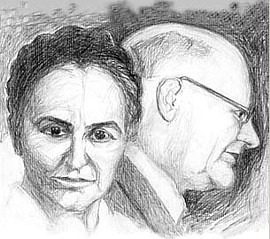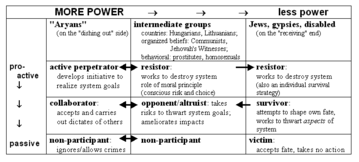Le Chambon’s Resistance to the Vichy Government and the Nazis (back
to top)
The teachings of Andre Trocme quickly spread throughout Le Chambon and
were widely accepted. The Trocme family was well liked and Andre quickly
filled the role of the moral and spiritual town leader. France fell to
the Nazis in 1940. It was divided in two areas--the Occupied Zone (occupied
by the Nazis) and the so-called Free Zone. Le Chambon was in this "Free
Zone." The Free Zone, however, also enforced anti-Semitic Nazi doctrines
and laws. Vichy government leader Marshal Petain signed a treaty with
the Nazi government, agreeing to hand over all the Jewish refugees that
the German government asked for. The day after this agreement was reached,
Trocme and Theis gave a sermon to their church discussing this and how
they should resist any government demands for refugees. Trocme’s speech
read as follows:
Tremendous pressure will be put on us to submit passively to a totalitarian
ideology. If they do not succeed In subjugating our souls, at least they
will want to subjugate our bodies. The duty of Christians is to use the
weapons of the Spirit to oppose the violence that they will try to put
on our consciences. We appeal to all our brothers in Christ to refuse
to cooperate with this violence…
Loving, forgiving, and doing good to our adversaries is our duty. Yet
we must do this without giving up, and without being cowardly. We shall
resist whenever our adversaries demand of us obedience contrary to the
orders of the gospel. We shall do so without fear, but also without pride
and without hate. (Moore)
This sermon began the Le Chambon resistance operation against the Vichy
and Nazi governments. It was a simple call of duty as Christians to simply
help out fellow humans in need. The Chambonnais only saw people in need,
no divisions between Christians and Jews; when someone asked for help
in the village, they would give it.
There were many things that the Chambonnais did to resist the Vichy
government and the Nazis. Most importantly, every Chambonnais that was
asked to hide and protect Jews did so. The Jews were housed in private
homes, on farms, and in public institutions. Louis Bulow, is the director
of the www.auschwitz.dk website and writes essays on the Holocaust. He
said whenever the Nazis came into Le Chambon, the Jews were hidden in
the countryside (Bulow). The Jews were provided this safe haven for as
long as they wanted. Pierre Sauvage said, that if asked by the Nazis and
Vichy government about these people living in their homes, they would
simply reply that they were cousins. Many Jews that lived on farms quickly
adapted and began working with the Chambonnais on the farms. No Chambonnais
ever asked the refugees if they were Jewish or not. They simply viewed
them as human beings who needed help. Not a single villager ever turned
a Jew over to the police. They also allowed Jews to make false identification
cards, which was a major risk to both them and the Jews.
The children refugees were very important to the Chambonnais. Pierre
Sauvage says that Le Chambon became known as "the village of children."
The Jewish children were educated alongside the other kids in the village.
Andre Trocme’s cousin Daniel was instrumental in setting up safe havens
for the children.
Le Chambon helped set up and was part of an underground railroad
leading to safety in Switzerland. The farming village served as the center
of the resistance in the region. Many of the Jews chose to use Le Chambon
as a place to hide and prepare to go to Switzerland.
Trocme’s congregation was not the only entity that fought to save
Jewish lives in Le Chambon. There were many other important organizations
in the village. The Quakers took an active role in helping hide and save
many Jews. Outside organizations like the Swiss Red Cross set up homes
and gave financial aid to house and shelter Jews. Private organizations
and persons did so later on during the war also. The director of the Shoah
Rose website, Elizabeth Kirkley Best said that the Darbyite community
in Le Chambon, a radical Protestant branch, also collaborated with Trocme
and the Chambonnais to help save Jews (Best). Other surrounding villages
on the chateau also hid some of the Jewish refugees.
These acts of hiding and protecting put the lives of those who performed
them in danger. In addition to risking their lives to hide Jews, the Chambonnais
under Trocme went even further. They frequently denied to Nazi officials
that they were hiding Jews. The Chambonnais stood up against the Vichy
government. On 1 August, 1941, all the towns of France had been instructed
to ring their church bells to celebrate the anniversary of Marshal Petain
coming to power. Pastor Trocme chose not to ring the bells, as a symbol
of resistance and opposition to the government and its actions.
In the summer of 1942, the village of Le Chambon was in danger. A
Vichy government official had arrived in Le Chambon and said that the
government knew Jews were hiding and living in Le Chambon. Trocme simply
responded with "These people came here for help and for shelter.
I am their shepherd. A shepherd does not forsake his flock. I do not know
what a Jew is. I know only human beings" (Bulow). This was a major
act of defiance. Two weeks later, the Vichy government police and Nazis
arrived with buses to take the Jews away. The officials and police demanded
Jews; Trocme simply responded that he did not have any Jews’ names and
even if he did he would not hand over a list to them (Hallie 108). Trocme
warned everyone who was hiding Jews, of the arrival of the police. The
next day was a Sunday. The police searched every house, but the entire
village, including the Jews, had packed Trocme’s church (Hallie 109).
The police searched the town for three weeks but did not find anyone and
the buses left completely empty.
The Chambonnais had successfully resisted the Vichy police and Nazis
and continued to do so each time they returned. Whenever new Jewish refugees
were coming, the Chambonnais would say how many "Old Testaments"
(Jews) were arriving in town (Best). When the Nazis came through the village,
many Jews were hidden in the countryside. According to a villager, "As
soon as the soldiers left, we would go into the forest and sing a song.
When they heard that song, the Jews knew it was safe to come home"
(Bulow).
|


